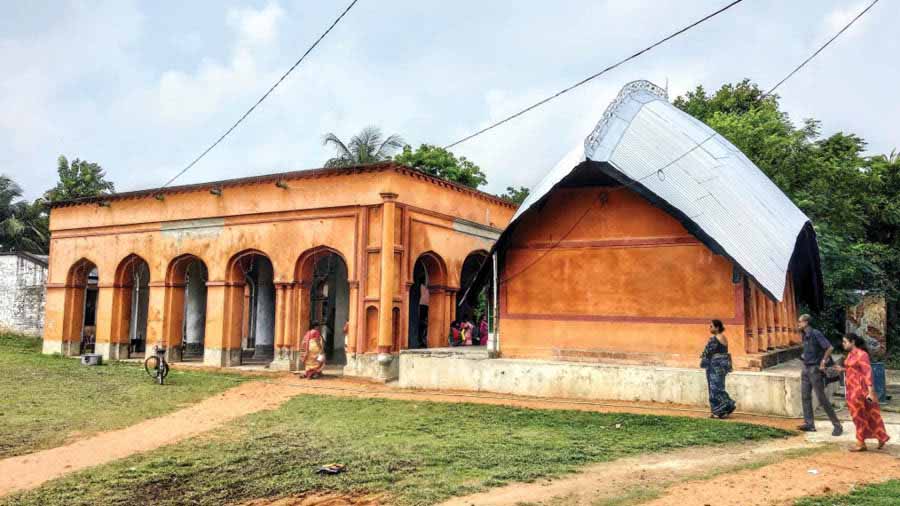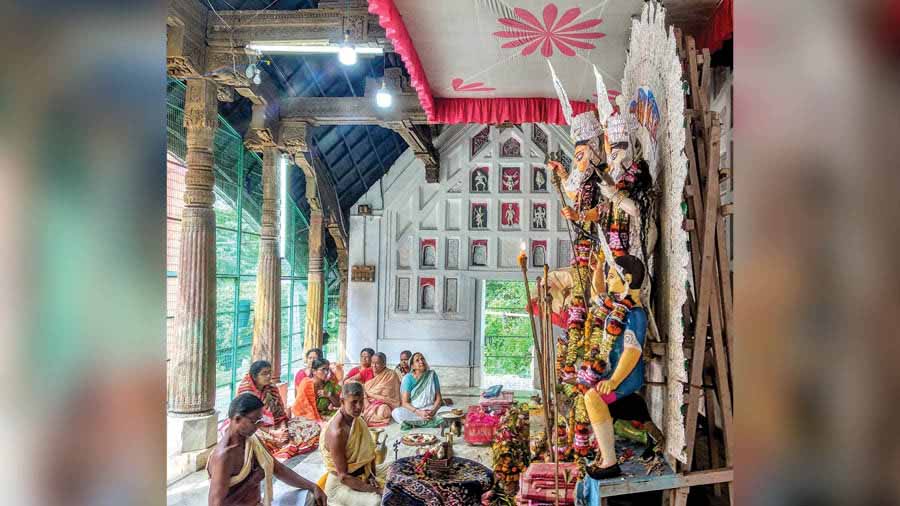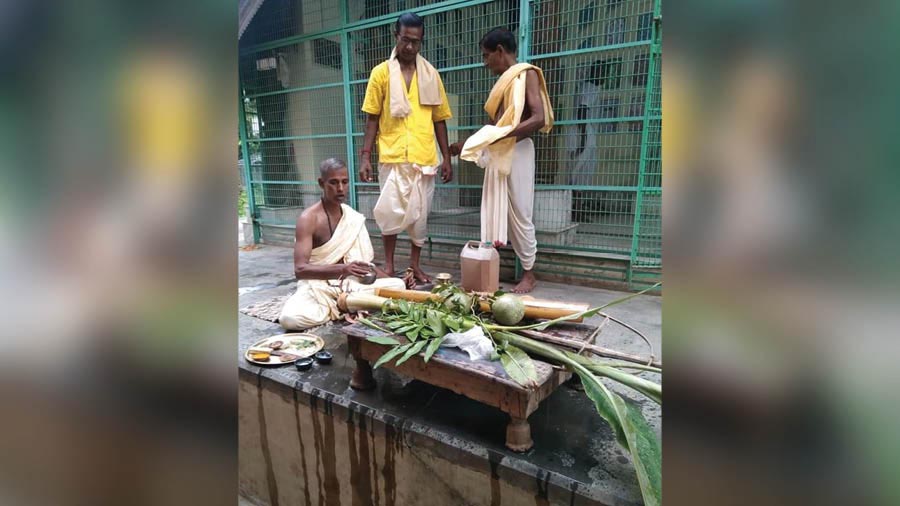Fifty-one, and not the usual 108, earthen lamps are lit for Sandhi Puja at the 316-year-old puja of a family in Sripur, Hooghly, that gets its name from a title believed to have been bestowed on one of its members by Aurangzeb.
Durga Puja at the Mitra Mustafi family home in Sripur is held inside a wooden Chandi mandap showcasing intricate designs on its walls and pillars. The Chandi mandap is one of its kind and there are few existing instances of such a structure where Durga Puja takes place.

The wooden Chandimandap with its adjacent Natmandir at Sripur Mitra Mustafi Bari. The roof is made of asbestos now Sk Abdul Amin
The family originally hailed from Birnagar (formerly known as Ula) in Nadia. A forefather of the family, Rameshwar Mitra, was sent on deputation to the imperial court in Delhi by Murshid Quli Khan. Rameshwar was a veteran accountant/ treasurer under Shaista Khan and solved a crucial accounting problem for the Mughal empire. Emperor Aurangzeb was so impressed that awarded Rameshwar the title “Mustoufi” or “Mustafi” and presented him with a golden palm (royal seal).
Rameshwar built many structures, of which a wooden Chandi mandap and a Jora Bangla temple remain. He had seven sons. The eldest son Raghunandan moved to Sripur in Hooghly, where he earned enough wealth to build a fortified home and started living there. Raghunandan built a Chandi mandap with a nat mandir in the same style of Ula Birnagar and started conducting Durga Puja from 1707. He also built a Radha Gobinda temple, a Ras Mancha and other temples.
The Chandi mandap still exists at the Ula Birnagar house although the intricate woodwork can hardly be seen. The fourth son of Rameshwar, Anantaram Mitra Mustafi, settled at Sukharia close to Sripur. An astadhatu idol of Mahishashur mardini is worshipped daily as well as during Durga Puja in the thakurdalan of the house.

Durga Puja being celebrated inside Chandimandap with intrinsic decorative woodwork on its wall Sk Abdul Ami
Bodhon at the Mitra Mustafi family puja starts on Krishna Navami with an animal sacrifice. The goddess is decorated with shola and wood. The Durga puja still takes place in the Chandi mandap.
The Nabapatrika ritual takes place on Saptami at the Chandi mandap. No cooked food is offered to the goddess during the puja. Instead, she is offered all kinds of spices along with ghee, cooking oil, milk and sugar. Raw vegetables like taro root, banana flower, banana stem, Malabar spinach (pui) and potato are offered. So are several types of fruits with the naibadya of uncooked rice along with kaju, raisins, pista, walnuts, cherry, dates and amsatwa (mango candy). Sweets offered include narkel naru, chandrapuli, sweets made of jaggery, sesame sweets. In the evening, the goddess is offered luchi along with chire and murki.

Raw vegetables fruits and sweets are offered as Bhog to the Goddess at Sripur Mitra Mustafi Bari
From Krishna Navami to the end of puja at Navami, uncooked bhog is offered to the Durga ghot. In the night, milk, chire, murki and khoi are offered. From Saptami onwards, there are some additions to the bhog. For example, luchi is offered only Saptami onwards.
The sankalpa is done in the name of the seven sons of Raghunandan Mitra Mustafi with seven silver coins. The homa kunda or Havan Kunda which burns continuously from Saptami to Navami is placed in a designated spot in front of the Chandi mandap. The fire is extinguished only by a Brahmin after the ritual of Dakshinanta (conclusion of a ceremony by paying the priest's fee) on Navami is over. From Saptami till the end of Dakshinanta, the widows of the village do not consume rice. The oldest member of the family goes around the whole village after Dakshinanta with a dhaki and informs everyone. After that, the widows wash their utensils and cook and eat rice.

Navapatrika rituals takes place inside Chandimandap of Sripur Mitra Mustafi Bari Sripur Mitra Mustafi family
On Ashtami, the ritual of mahasnan or royal bath of the goddess takes place. The various ingredients for the mahasnan kept in earthen pots are 1 kg 250 gms each of maida, gawa ghee, sesame oil, milk, curd, dolo chini (cane sugar) and honey. Everything is mixed together with holy water from the Ganga and poured over the reflection of the goddess on a silver-framed mirror as a symbolic bath.
The popular custom of blowing conch shell is not followed in the Durga Puja of the Mitra Mustafi family. Only dhaak is played. Conch shells are blown from the temple of Radhagobinda by a Brahmin in the afternoon and not from the Chandi mandap from bodhon till end of the Puja.
Senior family member Tapas Mustafi explained that only 51 earthen lamps are lit after Sandhi Pujo. Of the remaining 57, 14 are lit in the Radhagobinda temple on the day of Bhoot Chaturdashi, 28 lamps in front of goddess Kali on the day of Kali Puja and the remaining 15 on the same day in front of the Radhagobinda temple.
Six animals are sacrificed at the Mitra Mustafi family puja — a goat at bodhon, another on Saptami and two each on Ashtami and on Navami. The two sacrifices on Nabami are done one after another, one for Durga and one for Chamunda. The meat is not offered to the goddess but consumed by family members.
There is a ritual named “thandi pujo '' just after the animal sacrifice of Chamunda, which involves offering of cooling food items such as coconut, watermelon, citrus fruits. The yajna in the “hom kunda” starts after thandi pujo. An interesting detail to note is that 3028 leaves of bael are turned into ashes by sacrificing them in the fire, 1500 of them are burnt on each day of Saptami and Ashtami and 28 on Navami.

From Krishna Nabami to the end of puja at Nabami, uncooked bhog is continuously offered Sripur Mitra Mustafi family
After sindoor khela on Dashami, there is a practice of kanakanjali — a ritual usually associated with Hindu weddings where the bride offers grains to her mother at the time of leaving the parental home as a symbol of paying back all debt. Since the goddess is worshipped as a daughter in the puja, the head of the family hands over dried paddy, coins and a sindoor box to his wife as if received from the goddess. The wife accepts this and turns back.

The goddess is taken to the Hooghly river on a trolley for immersion. On the way back, the senior-most family members visit Manasatala in the nearby Rajbongshi Para and pay a token money. This is because the fishermen of this area had originally found the Radhagobinda and it was one of the terms on which they agreed to hand over the deity to the zamindar family.

